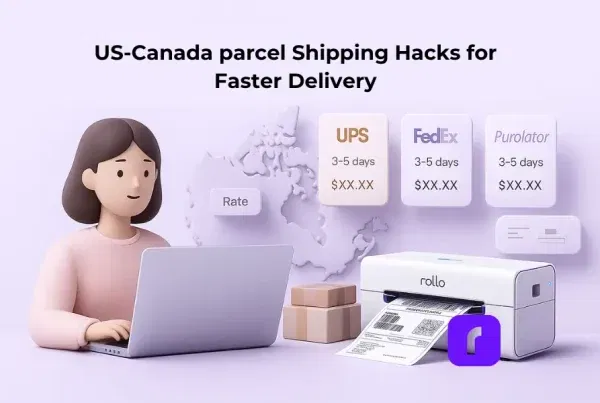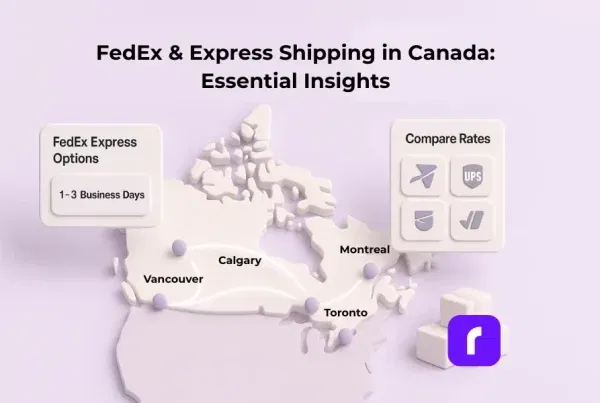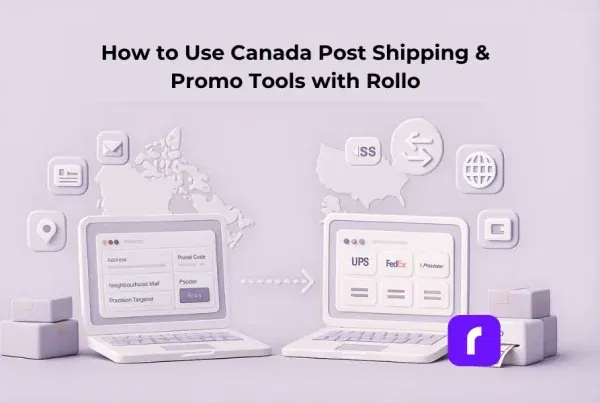Mercari selling is simple. First, make a free account and take clear photos of what you want to sell. Add a short description, choose a fair price, and pick Mercari’s prepaid shipping option. Mercari emails you a 4 × 6 label, and you have three days to ship the package. You only pay fees after your item sells: a 10 % selling fee, a 3.6 % buyer‑protection fee, and a 2.9 % + 50‑cent payment fee (sometimes Mercari waives the selling fee for new listings). Money is released when the buyer rates you or three days after delivery. You can get paid by free bank deposit or use Instant Pay for $3.
Pro tip: print labels with thermal label printers by Rollo to keep barcodes clear, ship faster, and avoid Mercari’s 8 % penalty for overweight packages.
If you’ve ever scrolled through Mercari and thought, “Could I make some extra cash here?”—the answer is yes, but success depends on more than snapping a photo and tapping List. This guide breaks down mercari selling for side hustlers and growing shops alike, showing you how to keep fees low, ship like a pro, and turn browsers into repeat buyers. By the end, you’ll know every step—from creating a listing to printing a label on a Rollo thermal printer—so you can sell with confidence.
Jump-to Guide
What Is Mercari Selling?
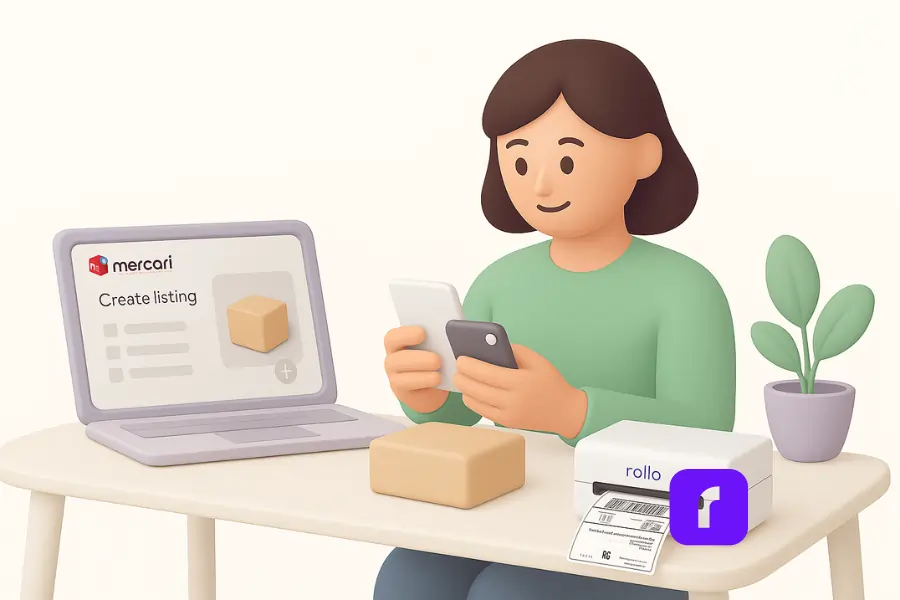
Mercari operates as a popular online marketplace where everyday users, hobby resellers, and SMBs meet millions of potential buyers. The app’s user‑friendly interface makes it easy to snap photos, set an item price, and collect payment once the item sells. Because Mercari couriers the transaction—holding funds until delivery confirmation—buyers feel protected, and sellers gain broader reach than a local yard sale.
For small businesses, Mercari selling is simple. The platform’s straightforward fee structure is a draw: you pay only when your item sells, so listing is essentially free. You also tap a broader audience than on your own site, which uplifts sales potential and helps you test new products without large ad budgets.
Mercari Selling Fees: What Sellers Really Pay
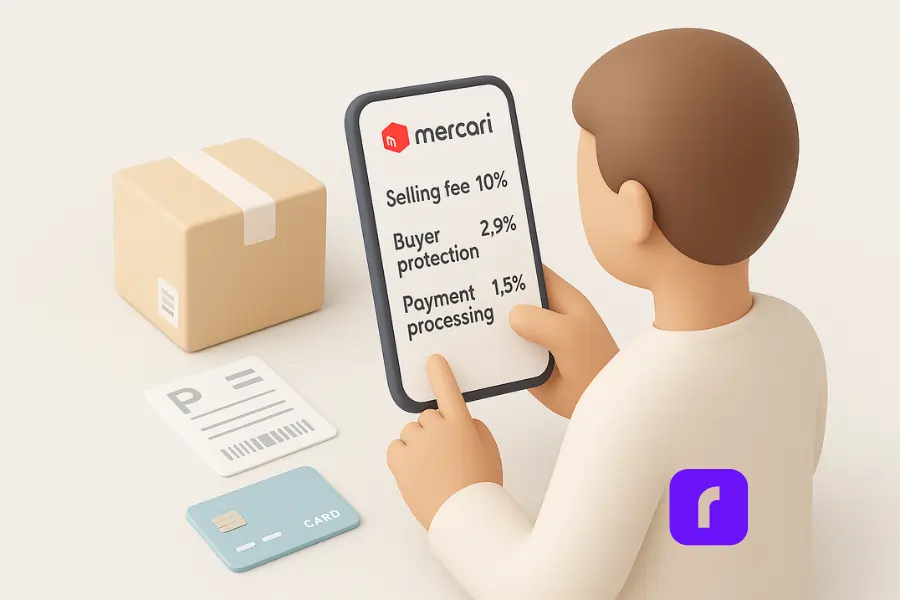
“Free to list” doesn’t mean free Mercari selling. Mercari’s new fee structure (updated March 2025) bundles several charges that chip away at profit if you’re not careful:
- 💰 Selling fee (10 %) – deducted from the combined amount of item price plus shipping if the buyer paid shipping
- 🛡️ Buyer protection fee (3.6 %) – passed to the shopper but still influences your item’s perceived cost
- 💳 Separate payment processing fee (2.9 % + $0.50) – covers card networks and fraud protection
- ⚡ Service fee for Instant Pay ($3) – if you can’t wait the standard schedule and want funds in minutes
- ⚠️ 8 % penalty – for packages that exceed the label’s weight or dimensions, piling atop any carrier adjustments
Payouts are typically processed via direct deposit to a bank account within two business days, but you can use Instant Pay to move up to $500 per month instantly to a debit card—handy for tight cash flow. Remember, though, the $3 service fee slices that margin.
How to Sell on Mercari (Even for Newbies)

Mercari selling starts with solid groundwork. First, confirm your identity through Mercari’s in‑app prompts; this additional identity verification unlocks higher listing limits and keeps your shop credible. Next, upload a clear profile picture so buyers know there’s a real person behind the store.
Photograph your item in bright light from multiple angles and write a concise description. If the product has a maximum length—think golf club or keyboard—add measurements to dodge buyer surprises. Set a competitive price: check recent sold listings to avoid overpricing and to sell quickly.
When you create the listing, you’ll choose shipping:
- Buyer Paid Shipping – Most common; Mercari calculates label cost based on weight.
- Offer Free Shipping – You absorb the cost but often earn more sales because shoppers love “free.”
- Ship on Your Own – Not recommended unless you’re confident with carrier rate tables.
After the sale, Mercari emails you a prepaid label. Print it, pack the order securely, and drop it off or schedule a postal service pickup. Mark the order as shipped in‑app so your buyer can track it in real time.
📦 Streamline Your Mercari Shipping with Rollo
Tired of juggling shipping tasks on Mercari? With Rollo’s suite of tools, you can simplify your shipping process, print labels effortlessly, and manage orders all in one place. Experience faster fulfillment, reduced errors, and significant savings.
Avoiding Common Mercari Selling Mistakes

A few missteps can turn an easy sale into a headache:
Guessing Package Weight Using a kitchen scale instead of a postal scale seems harmless until a box arrives one ounce over the limit. That triggers the dreaded 8 % penalty plus carrier adjustments. Weigh and measure twice before purchasing the label.
Ignoring Bundle Math Mercari encourages buyers to bundle items, but the system sometimes underestimates a combined amount. Manually confirm the weight to avoid paying out of pocket when you print the label.
Sloppy Labels Inkjet labels smudge and peel, leading to mis‑scans and negative reviews. Thermal labels from Rollo stay crisp and waterproof, ensuring packages sail through sorting machines.
Skirting Prohibited Items Mercari bans certain electronics, cosmetics, and anything recalled. A listing removed for prohibited items can tank your rating and limit future sales.
Ready to Simplify Your Mercari Selling and Shipping to Boost Sales?
With Rollo Ship, you’ll save time, avoid costly errors, and get every order out the door faster. Print 4×6 Mercari labels directly to your Rollo Wireless Printer, compare carrier rates, and manage your entire shipping process from one intuitive dashboard.
No more label resizing, no more shipping penalties—just seamless, stress-free fulfillment that keeps your small business growing.
Should You Only Sell on Mercari?
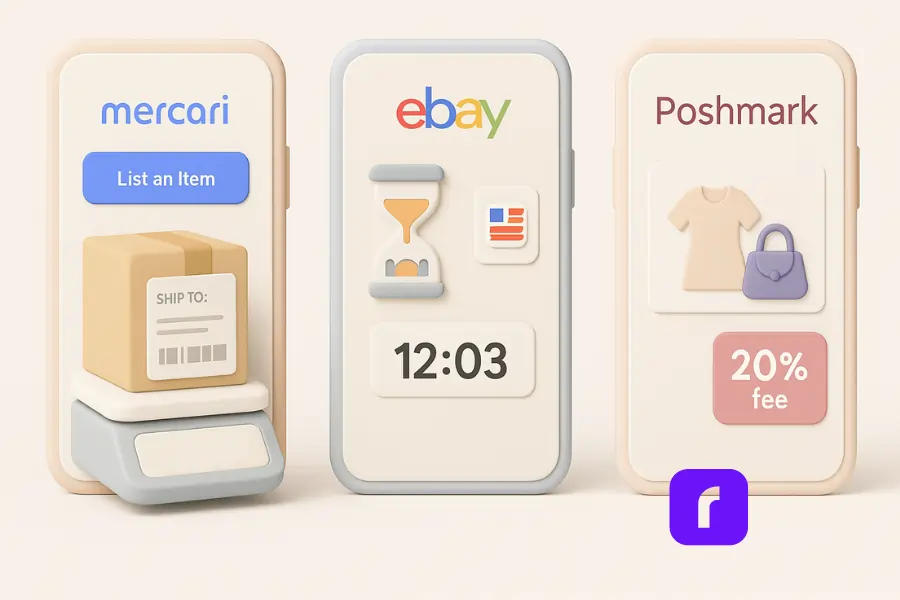
No single platform fits every seller. Compare Mercari with other platforms like eBay and Poshmark:
- 📱 Mercari – lower entry barrier, faster listing flow, stricter price limit per category ($2,000), and a “ship within 3 days” expectation.
- 🌍 eBay – auction dynamics and international reach but higher final value fees.
- 👗 Poshmark – social selling feed, strong for fashion, but a flat 20 % fee can sting.
For many SMBs, Mercari’s straightforward fee structure and active mobile audience offer a sweet spot—especially if you prefer packages moving fast rather than managing week‑long auctions.
How Rollo Optimizes Your Mercari Shipping
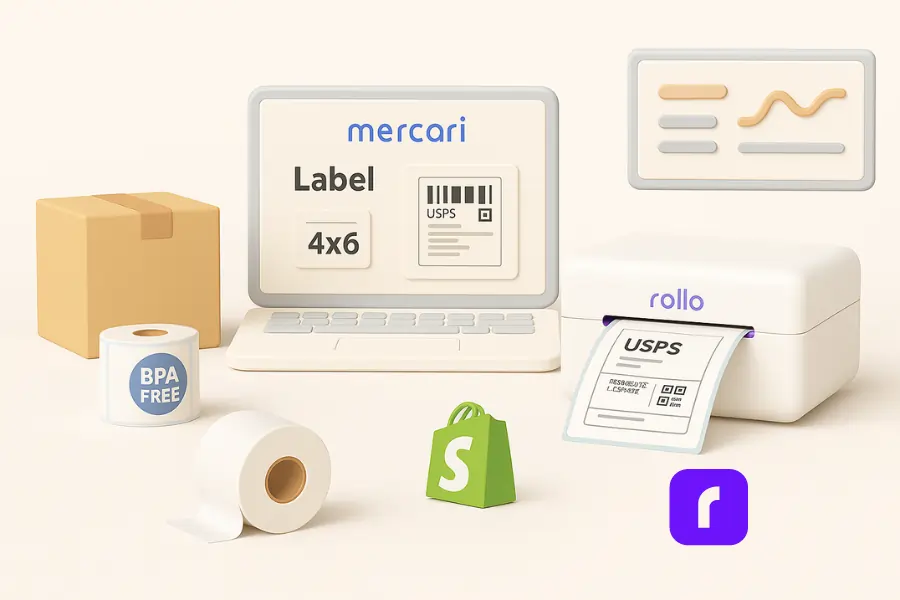
Shipping is where profits are won or lost. Start by locking in discounted rates through Mercari’s prepaid labels; you’ll often beat retail counter prices. Still, shipping costs add up, and mistakes cost more. Here’s how to streamline:
Mercari now supports native 4 × 6 labels. Pair that with a Rollo Wireless Label Printer, and you’ll print perfectly sized stickers in one click—no resizing or wasted paper. Thermal tech means no ink cartridges, trimming long‑term costs for stores that ship daily.
Because Rollo works with both a website and online marketplaces, you can print labels for Mercari, Amazon, or Shopify from the same device, making multitasking a breeze.
Curious how Rollo makes Mercari selling even better? Read our full guide here.
Plus, Rollo Ship’s dashboard shows every tracking number in one place, so you can answer buyer questions before they even ask.
Finally, Rollo offers BPA‑free labels, aligning with eco‑minded customers without raising your label cost.
Ship Your Mercari Orders the Smart Way—Wire‑Free, Ink‑Free, Penalty‑Proof
Print crisp 4 × 6 Mercari labels in a single tap with the Rollo Wireless Label Printer. Skip ink refills, avoid costly overweight mistakes, and get every package out the door faster.
What Is the 3‑Day Rule on Mercari?
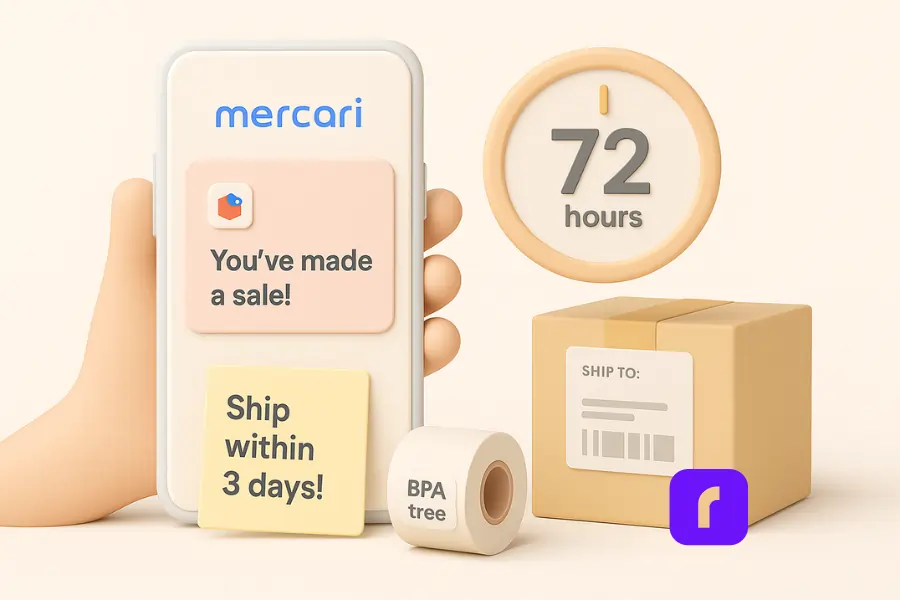
Mercari’s “3‑Day Rule” gives sellers 72 hours to ship after a sale. Miss the window and the buyer can cancel, your seller fees won’t be refunded, and your rating may drop. To stay safe, set reminders or print labels the same day the order comes in. Quick dispatch also boosts the algorithm’s confidence in your shop, pushing future listings higher.
Final Words
Mercari selling can turn closets—or full inventories—into revenue streams. By mastering the platform’s fees, choosing smart shipping options, and keeping packaging professional, you’ll avoid penalties and delight buyers. Technology matters too. A reliable thermal printer like Rollo not only saves money on supplies but also guards your reputation with scannable labels every time.
If you’re serious about growing on Mercari, it’s time to upgrade your toolkit. Start shipping with Rollo today and watch how seamlessly those “Item Shipped” notifications roll out.
Follow Rollo on:
Frequently Asked Questions About Mercari Selling
📌 Q: How much does Mercari charge to sell?
💭 A: Mercari deducts a 10 % selling fee, a 3.6 % buyer protection fee, and a 2.9 % + $0.50 payment processing fee from each completed transaction.
📌 Q: Is Mercari selling safe for small businesses?
💭 A: Yes. Mercari holds funds until delivery confirmation, offers shipping protection, and uses Mercari Authenticate on high‑value items, making it a secure channel when you follow all rules.
📌 Q: What happens if I ship an overweight package on Mercari?
💭 A: The platform adds an 8 % penalty to the sale plus any extra carrier charges, so weigh and measure before buying your label.
📌 Q: Can I print Mercari labels with a thermal printer?
💭 A: Absolutely. Mercari’s 4 × 6 label format prints perfectly on Rollo thermal printers, saving you paper, ink, and time.
📌 Q: When will I get paid after a sale?
💭 A: Payouts are typically processed to your bank account within two business days, but you can use Instant Pay—for a $3 fee—for near‑instant access to funds on your debit card.
Happy selling—and even happier shipping!
